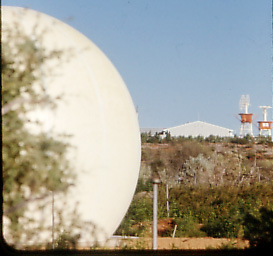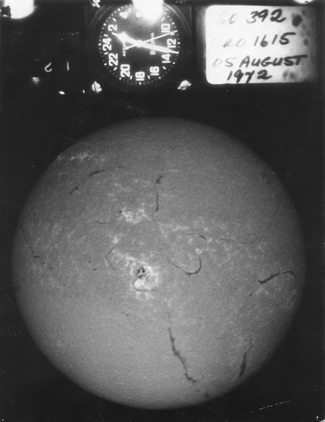Span 2
Solar Particle Alert Network

The Solar Particle Network (SPAN) is devoted primarily to the observation of flares on the surface of the Sun.
Flares are an eruption of the face of the Sun. They show up as intense brightenings of small sections of the solar surface. Flares usually occur near sun spots. Flares begin rapidly (with explosive velocities) and may last up to five hours.
Flares emit vast amounts of radiation, (gamma radiation, ultraviolet radiation, x-ray radiation, visible radiation, infrared radiation, radio waves, and sometimes proton radiation.) Exposure of the human body to solar radiation is damaging and in extreme cases may be fatal. Most of the solar radiation shoots off to the realms of space beyond the solar system. Some of the solar radiation hits Earth and is absorbed in the upper atmosphere. Thus, we on Earth's surface are protected from solar radiation by our upper atmosphere.
Astronauts orbiting the Earth are outside the protection of the Earth's atmosphere and are vulnerable to solar radiation. NASA established the SPAN network to provide a means of observing flares and warning astronauts. There were three (3) SPAN stations: Carnarvon, Australia; Canary Islands, Spain; Boulder, U.S.A. The SPAN stations were situated roughly 1200 longitude apart and at any one time, always one and sometimes two, of the SPAN stations were able to watch the sun. If flares above a certain size were observed, the SPAN station could use a satellite telephone to immediately notify NASA Flight Directors in Houston, U.S.A., who could immediately inform the astronauts of what protective measures were necessary.
As well as its responsibilities to NASA, the SPAN network provided data to an international network for forecasting fade outs of long distance radio communications.
During the Skylab flights, SPAN provided pointing data for the astronauts to use, to aim their research telescopes at probable flares centres on the sun.
The main equipment used at SPAN comprised an Optical Telescope and a Radio Telescope. The Optical Telescope was situated in the Dome on top of the SPAN building. It included a television camera and a 35 mm camera which automatically photographed the sun every thirty (30) seconds; The Optical Telescope followed the sun automatically.
A small Radio Telescope tracked the sun all day and measured the intensity of three (3) different frequencies of solar radio emission. The intensities were displayed on moving chart recorders in the SPAN building. The three particular frequencies were chosen because of their relevance to solar activity. Solar radio emission rises dramatically during flares. The Radio Telescope was in the white Radome at the North side of the SPAN building.

35mm photograph of the sun